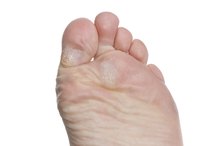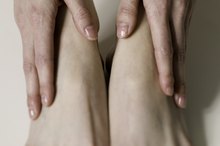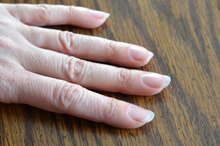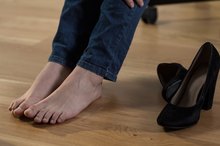Symptoms of Diabetes in the Feet
For the average, healthy person, taking care of their feet is relatively simple. Keeping their feet clean by washing them every day, trimming their toenails and making sure that their shoes fit properly are essential. But, for the diabetic, routine foot care can not only become a complicated nuisance, it can even become life threatening.
The secret to maintaining healthy feet for the diabetic includes a thorough understanding of their condition, getting regular examinations, choosing proper fitting footwear, being on the lookout for trauma to the feet, knowing how to treat simple problems and knowing when to see a doctor for follow-ups.
Understanding Diabetic Foot Problems
Unlike people without diabetes, foot care for the diabetic is extremely important and requires constant monitoring. Diabetes (both type I and type II) results in the body not getting proper nutrients to tissues. While heart disease, kidney and liver disease can result from poorly controlled diabetes, damage to the lower extremities can be just as serious. Diabetics who fail to monitor their disease can often lose toes, fingers and entire extremities through amputation.
All healthy tissue requires an adequate blood supply to insure that the proper nutrients are delivered to them and that waste products are removed. In the case of diabetes, nerves, blood vessels and an impaired immune system contributes to the deterioration of the feet. When this occurs, bacterial infections can set in, making it difficult to treat the conditions with antibiotics.
Many diabetics lose feeling in their feet and are completely unaware when they develop cuts, blisters and infections. Something as simple as a blister can lead to blood poisoning and loss of limb.
Simple Symptoms Become Severe Problems
How to Treat Cracked Diabetic Feet
Learn More
Diabetics must be particularly aware of things like how to choose proper socks and insuring that their shoes fit properly. Something as simple as a rough seam on a pair of socks can lead to irritation and infection. Other things for diabetics to be aware of are blisters, corns, bunions and even sore spots caused by friction between the feet and the inside of shoes.
Some diabetics suffer from "peripheral neuropathy." Peripheral neuropathy is the degeneration of the nerves that supply feeling to the hands and feet. Diabetics who suffer from peripheral neuropathy can go days or weeks before noticing simple injuries that have progressed into serious complications.
Diabetics with peripheral neuropathy also suffer from poor circulation, infections and other diseases such as athlete's foot and ingrown toenails. If they smoke cigarettes, there is also a likelihood that the circulation to their feet is impaired, which can lead to other problems.
Looking for Diabetic Foot Problems
The most common indication of a foot problem in the diabetic is swelling, redness and inflammation. These can start with a common sprain, bruise, ill-fitting shoes, swollen feet, localized warmth of the skin, cuts or wounds that do not heal, fever and chills and red streaks that emanate from a wound. If left untreated, numbness and nerve damage can progress and lead to even more serious problems.
Care for Diabetic Wounds
Foot Calluses & Duct Tape
Learn More
If the diabetic's physician determines that their wounds require treatment, there are a variety of approaches they can take. In the case of infections, their doctor may prescribe one or more antibiotics to help control the infection.
If the diabetic's wounds have progressed beyond the care their physician can offer in his office, they may be referred to a wound care center where they can have their wounds irrigated, cleansed and treated surgically.
They may also be referred to a podiatrist or orthopedic surgeon to assist them with choosing the proper types of shoes, orthotics and correcting other contributing factors such as corns, calluses, hammertoes, bone spurs and arthritis.
The Importance of Home Health Care
Diabetics do not necessarily have to experience a life fraught with foot problems. Home health care and frequent examinations can help head off minor issues before they become serious.
Diabetics with a history of foot problems should get in the habit of carefully examining their feet every day and being on the lookout for new bruises, cuts or "warm spots" that can lead to infection. Even something as simple as inspecting the inside of their shoes for rough spots or seams can help to eliminate problems that can irritate their feet.
Diabetics need to take particular precautions when walking with bare feet. Something as simple as stepping on a small stone could lead to serious problems in the future. They also need to keep their toe nails trimmed and avoid cutting them too deeply.
Getting regular exercise using proper fitting shoes will help to increase circulation to their lower extremities.
Diabetics who smoke cigarettes should quit. Smoking diminishes circulation to the lower extremities.
Finally, diabetics need to monitor their blood glucose levels daily and keep them within normal ranges by working with their health care specialists.
Related Articles
Writer Bio
Allen Smith is an award-winning freelance writer living in Vail, Colo. He writes about health, fitness and outdoor sports. Smith has a master's degree in exercise physiology and an exercise specialist certification with the American College of Sports Medicine at San Diego State University.









